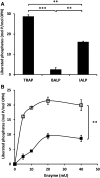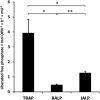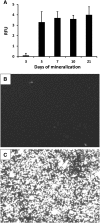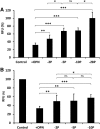Bone Alkaline Phosphatase and Tartrate-Resistant Acid Phosphatase: Potential Co-regulators of Bone Mineralization
- PMID: 28303318
- PMCID: PMC5486932
- DOI: 10.1007/s00223-017-0259-2
Bone Alkaline Phosphatase and Tartrate-Resistant Acid Phosphatase: Potential Co-regulators of Bone Mineralization
Abstract
Phosphorylated osteopontin (OPN) inhibits hydroxyapatite crystal formation and growth, and bone alkaline phosphatase (BALP) promotes extracellular mineralization via the release of inorganic phosphate from the mineralization inhibitor inorganic pyrophosphate (PPi). Tartrate-resistant acid phosphatase (TRAP), produced by osteoclasts, osteoblasts, and osteocytes, exhibits potent phosphatase activity towards OPN; however, its potential capacity as a regulator of mineralization has not previously been addressed. We compared the efficiency of BALP and TRAP towards the endogenous substrates for BALP, i.e., PPi and pyridoxal 5'-phosphate (PLP), and their impact on mineralization in vitro via dephosphorylation of bovine milk OPN. TRAP showed higher phosphatase activity towards phosphorylated OPN and PPi compared to BALP, whereas the activity of TRAP and BALP towards PLP was comparable. Bovine milk OPN could be completely dephosphorylated by TRAP, liberating all its 28 phosphates, whereas BALP dephosphorylated at most 10 phosphates. OPN, dephosphorylated by either BALP or TRAP, showed a partially or completely attenuated phosphorylation-dependent inhibitory capacity, respectively, compared to native OPN on the formation of mineralized nodules. Thus, there are phosphorylations in OPN important for inhibition of mineralization that are removed by TRAP but not by BALP. In conclusion, our data indicate that both BALP and TRAP can alleviate the inhibitory effect of OPN on mineralization, suggesting a potential role for TRAP in skeletal mineralization. Further studies are warranted to explore the possible physiological relevance of TRAP in bone mineralization.
Keywords: Bone; Dephosphorylation; Hydroxyapatite; Inorganic pyrophosphate; Mineralization; Osteopontin.
Conflict of interest statement
Conflict of interest
The authors Cecilia Halling Linder, Barbro Ek-Rylander, Michael Krumpel, Maria Norgård, Sonoko Narisawa, José Luis Millán, Göran Andersson, and Per Magnusson declare that they have no conflict of interest.
Human and Animal Rights and Informed Consent
This article does not contain any studies with human or animal subjects performed by any of the authors.
Figures





Similar articles
-
Pyrophosphate inhibits mineralization of osteoblast cultures by binding to mineral, up-regulating osteopontin, and inhibiting alkaline phosphatase activity.J Biol Chem. 2007 May 25;282(21):15872-83. doi: 10.1074/jbc.M701116200. Epub 2007 Mar 23. J Biol Chem. 2007. PMID: 17383965
-
Osteoclast migration on phosphorylated osteopontin is regulated by endogenous tartrate-resistant acid phosphatase.Exp Cell Res. 2010 Feb 1;316(3):443-51. doi: 10.1016/j.yexcr.2009.10.019. Epub 2009 Oct 23. Exp Cell Res. 2010. PMID: 19854170
-
In vivo overexpression of tissue-nonspecific alkaline phosphatase increases skeletal mineralization and affects the phosphorylation status of osteopontin.J Bone Miner Res. 2013 Jul;28(7):1587-98. doi: 10.1002/jbmr.1901. J Bone Miner Res. 2013. PMID: 23427088 Free PMC article.
-
The mechanism of mineralization and the role of alkaline phosphatase in health and disease.J Nippon Med Sch. 2010 Feb;77(1):4-12. doi: 10.1272/jnms.77.4. J Nippon Med Sch. 2010. PMID: 20154452 Review.
-
[Pyrophosphate and mineralization (TNSALP, PC-1, ANK)].Clin Calcium. 2007 Oct;17(10):1574-9. Clin Calcium. 2007. PMID: 17906411 Review. Japanese.
Cited by
-
CB1 receptor antagonist rimonabant protects against chronic intermittent hypoxia-induced bone metabolism disorder and destruction in rats.Sleep Breath. 2020 Dec;24(4):1441-1449. doi: 10.1007/s11325-019-02009-9. Epub 2020 Jan 2. Sleep Breath. 2020. PMID: 31898189 Free PMC article.
-
Challenges and Perspectives Regarding the Determination of Gingival Crevicular Fluid Biomarkers During Orthodontic Treatment: A Narrative Review.Medicina (Kaunas). 2024 Dec 4;60(12):2004. doi: 10.3390/medicina60122004. Medicina (Kaunas). 2024. PMID: 39768884 Free PMC article. Review.
-
Circular RNA SIPA1L1 promotes osteogenesis via regulating the miR-617/Smad3 axis in dental pulp stem cells.Stem Cell Res Ther. 2020 Aug 24;11(1):364. doi: 10.1186/s13287-020-01877-3. Stem Cell Res Ther. 2020. PMID: 32831141 Free PMC article.
-
Cordycepin Accelerates Osteoblast Mineralization and Attenuates Osteoclast Differentiation In Vitro.Evid Based Complement Alternat Med. 2018 Oct 16;2018:5892957. doi: 10.1155/2018/5892957. eCollection 2018. Evid Based Complement Alternat Med. 2018. PMID: 30410556 Free PMC article.
-
Magnetic Graphene Oxide Nanocomposites Boosts Craniomaxillofacial Bone Regeneration by Modulating circAars/miR-128-3p/SMAD5 Signaling Axis.Int J Nanomedicine. 2024 Apr 3;19:3143-3166. doi: 10.2147/IJN.S454718. eCollection 2024. Int J Nanomedicine. 2024. PMID: 38585472 Free PMC article.
References
Publication types
MeSH terms
Substances
Grants and funding
LinkOut - more resources
Full Text Sources
Other Literature Sources
Research Materials

